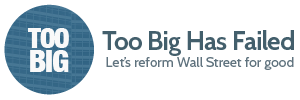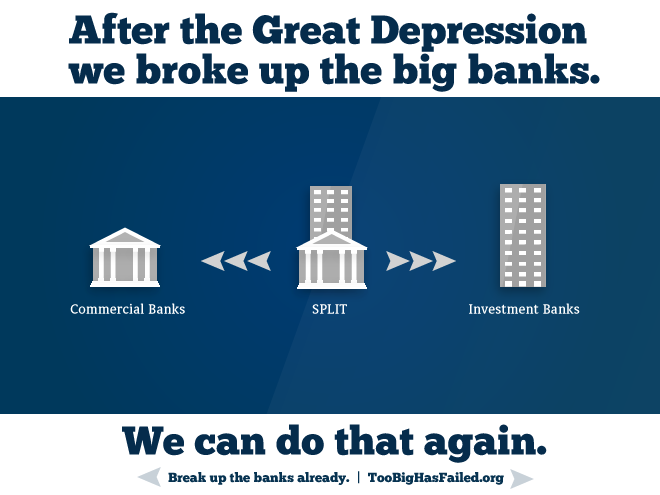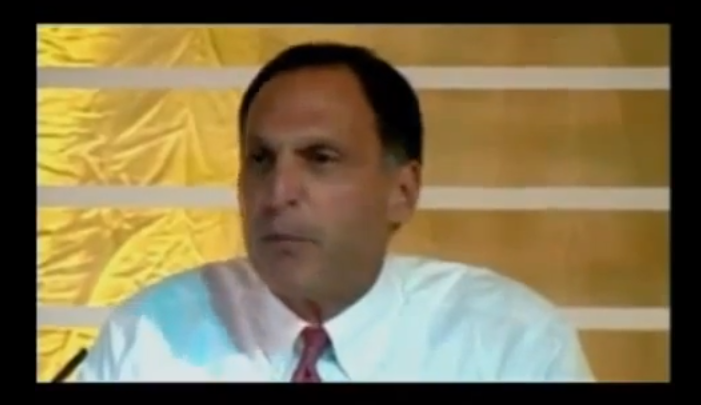In our last post we talked about a new proposal to restore the Glass-Steagall Act of 1933, an act that separated commercial banking from investment banking.
It’s a proposition that has plenty of critics, many of whom say that Glass-Steagall wouldn’t have prevented the last crisis (see here, here, and here). In response, we’ve listed three reasons (numbers 4, 5, and 6 below) showing that the repeal of Glass-Steagall did in fact play a role in the crisis and that people should therefore support restoring it. Here’s the list:
1. It Will Break Up Chase, Bank of America, and Citi
By international accounting standards, these three banks are the biggest in world. They are also the prime examples of banks that have enormous combined commercial and investment enterprises. What this means is that these banks are increasingly unwieldy, and in the words of former FDIC chair Sheila Bair they’re simply “too big to manage.”
2. It Will Fracture Wall Street’s Lobbying Power

photo from flickr
In a Bloomberg video and in an article in the Financial Times, University of Chicago economist Luigi Zingales argues that restoring Glass-Steagall will fracture Wall Street’s lobbying power. He says, “Under the old regime, commercial banks, investment banks and insurance companies had different agendas, so their lobbying efforts tended to offset one another. But after the restrictions ended, the interests of all the major players were aligned.” It’s no wonder, then, that Wall Street’s power in Washington has increased in recent years.
3. Glass-Steagall Is Simple
Separating commercial banking activity from investment banking activity is a simple way to keep banks smaller. This simplicity is reflected in the bill itself: The original Glass-Steagall Act was 37 pages, for instance, while the 2010 Dodd-Frank Act will potentially reach 30,000 pages of rules.
Of course, simplicity in itself isn’t reason enough to support a bill, but it’s a reason that shouldn’t be overlooked. After all, the global economy gets exponentially more complex each year, and so it’s imperative to compensate that complexity with simple regulations—not lots of red tape and loopholes. “The simpler a rule is,” Luigi Zingales says, “the fewer provisions there are and the less it costs to enforce them. The simpler it is, the easier it is for voters to understand and voice their opinions accordingly. Finally, the simpler it is, the more difficult it is for someone with vested interests to get away with distorting some obscure facet.”
We need a few simple laws on Wall Street. Glass-Steagall is one such law.
4. It Would Have Prevented AIG’s Major Role In the Financial Crisis

photo from flickr
In his testimony to the Financial Crisis Inquiry Commission, Former Superintendent Eric Dinallo argued that AIG wouldn’t have been so laden with risk if they hadn’t been able to function like a hedge fund. He says that the repeal of Glass-Steagall, “permitted AIG to operate an effectively unregulated hedge fund with grossly insufficient reserves to back up its promises. Had AIG Financial Products been a stand alone company, it is unlikely that its counterparties would have been willing to do business with it because its commitments would never have carried a triple-A credit rating.”
Since AIG was at the heart of the bailouts, the repeal of Glass-Steagall played a major role in the financial crisis.
5. Citi Wouldn’t Have Been Run By Someone Who Didn’t Understand Commercial Banking
Vikram Pandit (pictured above) hadn’t ever worked as a commercial banker before becoming CEO of Citi in 2007. As Sheila Bair once said, Pandit “wouldn’t have known how to underwrite a loan if his life depended on it.” His lack of experience with commercial banking was problematic during the crisis because Citi was the sickest of all banks that received bailout money—requiring $472.6 billion in cash and guarantees. Pandit would have never been in charge of such a large commercial banking enterprise if Glass-Steagall hadn’t been repealed. Instead, he would have stuck with what he knew: investment banking.
6. Investment Banks Wouldn’t Have Faced as Much Competitive Pressure During the 2000s
The man in the picture above is Dick Fuld, the CEO of Lehman Brothers, an investment bank that went bankrupt in the crisis. Fuld was insanely competitive, as we saw in A Colossal Failure of Common Sense as well as this internal video, where Fuld shows his disdain for people betting against Lehman by saying, “I want to reach in, rip out their heart, and eat it before they die.” (Yikes.) Fuld desperately wanted to be a top dog on Wall Street, and the repeal of Glass-Steagall made that much, much more difficult because it created the sudden influx of big competition from commercial banks. Fuld’s blindly competitive spirit led him to overextend Lehman and eventually go bankrupt.
Of course, the repeal of Glass-Steagall didn’t in itself cause Fuld to overextend, but it’s clear that Lehman and other investment banks like Bear Stearns wouldn’t have faced nearly so much competitive pressure if commercial banks like Citi hadn’t suddenly entered the investment banking scene after 1999.
This report from Public Citizen (pdf) reveals more about why “The absence of Glass-Steagall … was intrinsic to Lehman’s collapse,” showing that Lehman itself admitted they were feeling intense pressure in 2005 from the repeal of Glass-Steagall.
7. Plenty of Smart People Support Restoring Glass-Steagall
Here’s a list of people in the video above who support Glass-Steagall:
0:07 - Bill Moyers (PBS) and Matt Taibbi (Rolling Stone discuss how little has changed since 2008).
0:27 - Robert Reich (fmr Labor Sec) explains why we need to break up the biggest banks
0:47 - Sandy Weill (CEO, Citigroup) explains why he wants the banks to be broken up
1:04 - Byron Dorgan gives the successful history of breaking up the banks.
1:32 - James Rickards lists the folks who allowed the banks to get big again.
1:41 - James Komansky (fmr CEO, Merril Lynch) regrets his decision to allow banks to get big again.
1:57 - Luigi Zingales (economist, Univ. of Chicago) on the danger of consolidated banks.
2:13 - Sheila Bair (fmr FDIC Chair) on why she would like to see the banks broken back up.
2:30 - Joseph Stiglitz (Nobel laureate, Columbia economist) on why we don’t have ordinary capitalism when banks are so big.
2:40 - Nouriel Roubini (NYU economist) “if institutions are too big to fail, they are too big.”
2:54 - Simon Johnson (MIT economist)
3:18 - Neil Barofsky (TARP inspector) explains exactly what needs to happen.
3:41 - Elizabeth Warren
4:00 - Bernie Sanders
4:17 - Ted Kaufman
*You can see more from MIT economist Simon Johnson in his articles “Five Facts About the New Glass-Steagall,” where he says that Glass-Steagall would be good for small banks, and in “Remember Citigroup,” where he says that the repeal of Glass-Steagall was directly responsible for Citi’s problems in the crisis. You can also see more from University of Chicago economist Luigi Zingales in his article “Why I Was Won Over By Glass-Steagall,” where he explains why he was initially resistant to the law, and why he now supports it.
In addition to the sixteen people shown in the video above, here are some more quotes from others who want to restore the law:
Barry Ritholtz, chief executive of FusionIQ, an asset management and research firm: “For about 70 years, Glass-Steagall managed to keep the riskier, more damaging part of Wall Street away from what should be the boring, straightforward side of finance. It was the height of stupidity repealing Glass-Steagall.”
Arthur Levitt, former Wall Street regulator: “Clearly, I regret my support of doing away with Glass Steagall.”
John Reed, former Citi CEO: “As another older banker and one who has experienced both the pre- and post-Glass Steagall world, I would agree with Paul A. Volcker (and also Mervyn King, governor of the Bank of England) that some kind of separation between institutions that deal primarily in the capital markets and those involved in more traditional deposit-taking and working-capital finance makes sense. This, in conjunction with more demanding capital requirements, would go a long way toward building a more robust financial sector.”
Thomas Hoenig, FDIC director: “When you mix commercial banking and high-risk broker-dealer activities, you increase the risk overall and as a result you invite new problems.”
Dean Baker, economist for the Center for Economic Policy and Research: “I think there are a lot of ways to make [the big banks] less powerful, less politically powerful, less economically powerful. Glass-Steagall, again I’d like to see that sort of separation.”
Andrew Haldane, Executive director of the Bank of England, calls Glass-Steagall “perhaps the single most important piece of financial legislation of the 20th century.”
Conclusion
Restoring Glass-Steagall won’t guarantee prevention of future financial crises, just as it (alone) wouldn’t have prevented the last one. However, restoring Glass-Steagall is a simple way to reduce the size of Wall Street banks, and its repeal certainly did play a part in the last crisis. Its for those reasons, as well as the others listed above, that the law should be restored.
We’ll conclude with this passage from Simon Johnson’s article “Remember Citigroup,” which argues that the New Glass-Steagall law should be a complement to other propositions to fix banking. We strongly agree with this notion:
The point of the New Glass-Steagall Act is to complement other measures in place or under consideration, including much higher capital requirements (both in the Brown-Vitter proposed legislation and in the new regulatory cap on leverage now under consideration), the Volcker Rule, and efforts to bring greater transparency to derivatives.
These measures are not substitutes for each other – they are complements. Each would be more effective if the others are also implemented properly.
Nothing can completely remove the risk of future financial crisis. Anyone who promises this is offering up illusions and deception.
But, like it or not, public policy shapes incentives in the financial system. We can have a safer financial system that works better for the broader economy – as we had after the reforms of the 1930s. Or we can have a system in which a few relatively large firms are encouraged to follow the model of Citigroup and to become ever more careless and on a grander scale.
Also see our last post on the new Glass-Steagall Act.









What about Lyndon LaRouche, who opposed the 1999 Gramm-Leach-Bliley Act (the “Derivative Decriminalisation Act”, watch http://youtu.be/mDsHNyVrhvE), in 2007 proposed a Homeowners and Bank Protection Act and since 2009 pushes for Glass-Steagall resurgence?